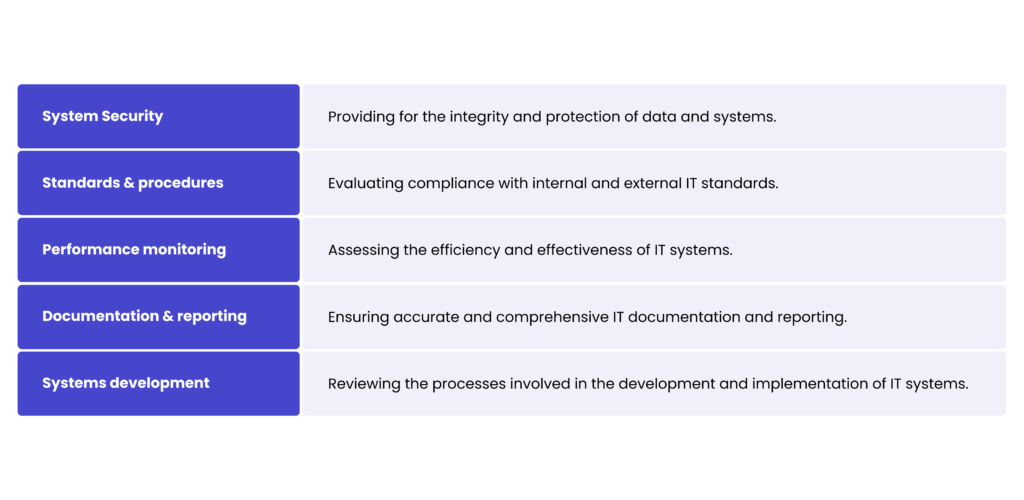What to expect during an IT system audit
Effective IT infrastructure management is becoming critical to the operation and development of any business. The Global Technology Audit Risks Survey and the Institute of Internal Auditors reveals that 60% of IT auditors consider the risks associated with third-party vendors to be significant, particularly in terms of security, reliability and resilience.
As security, compliance and system performance requirements become more complex, regular assessment and optimisation of the IT environment is essential to ensure business continuity and minimise risk. In this context, auditing is becoming an indispensable tool for identifying vulnerabilities in IT systems and assessing their compliance and cost-effectiveness. In this article, we will discuss exactly what an IT audit is, the areas it covers and the benefits it can bring to the organisation
What is an IT system audit?
IT audit is a process of comprehensive analysis of an organisation’s infrastructure, applications, code and/or IT systems to assess their technical condition, security, performance and compliance with standards. The audit may involve evaluating the work of previous suppliers, checking the quality of implemented solutions, optimising costs or assessing the stability and security of systems.
It is carried out for a variety of reasons, for example to assess the quality of the previous supplier’s work, to prepare for the migration of the application, or simply to understand the technical state of the application, the infrastructure and its development capabilities. The audit is also a tool for identifying risks and opportunities for improvement, e.g. in terms of performance, security or cost optimisation.
The importance of an IT audit
IT audits play a key role in assessing an organisation’s technological background, identifying potential security threats, system gaps and regulatory non-compliance.
With up to 42% of organisations experiencing cyber security fatigue, errors occur more frequently than one might expect.
Audits can help companies to improve data protection by reducing the risk of threats, and also assess the effectiveness of IT resource management, promoting both improved efficiency and better alignment with business objectives.
A detailed analysis of the reliability of data processing and storage systems helps maintain IT consistency and integrity within an organisation. Audits assess whether operational processes are performing as expected, including disaster recovery plans and business continuity strategies. If irregularities are found, they provide guidance on how to correct them and improve operations.
Core areas of an IT audit

While audits will methodically examine these areas, it’s important to recognise that each organisation’s needs are unique. It is essential that auditors tailor their assessment to the specific needs and infrastructure of the business.
Essentials of an IT audit provided by Spyrosoft
Risk assessment – involves identifying and evaluating potential threats and vulnerabilities in the organisation’s IT systems. Our experts analyse what risks may affect the integrity, security and continuity of IT systems, as well as the impact of their implementation. The main objective is to identify areas that require special attention in the next stages of the audit.
Security review – this stage involves reviewing the security mechanisms currently implemented in the organisation. Activities focus on security policies, firewalls, intrusion detection systems, access management and data encryption. The assessment aims to determine whether these measures are properly configured and meet security standards to protect IT assets from cyber-attacks and other threats.
Data management & integrity – a review of data management procedures, including methods for storing, processing and protecting sensitive data. This step includes checking that the data is complete, accurate and complete, and that there are mechanisms in place to prevent its loss or corruption. It is also important to assess how the company manages backups and the disaster recovery plan.
Compliance verification – in this phase, we verify that the organisation’s IT systems comply with relevant legislation, industry standards and regulations, such as GDPR, ISO 27001, HIPAA and other industry-specific requirements.
System performance analysis – an assessment of the performance, functionality, reliability and ability to handle operational loads of IT systems. The analysis includes an assessment of the speed of operation, availability of systems and their scalability. The aim is to ensure that systems are efficient enough to meet the needs of the business.
Detailed report – the documentation that we provided to the client at the end of the audit. It contains a detailed analysis, presented in a transparent manner and accessible to all parties. The report is designed to give the client complete freedom of choice. They can present the report to their current technology partner or pass it on to another vendor if they decide to outsource the remediation or implementation of the recommendations.
Each audited area is discussed in detail and has an associated list of recommendations, which we often produce as separate documents. These recommendations include specific actions to be taken, including improvements, repairs or the implementation of new technology solutions.
Benefits
Risk management
An IT audit helps identify gaps and risks in systems, including potential security threats, data breaches and compliance gaps. It will enable your organisation to take preventative action and increase overall security.
Regulatory compliance
Audits ensure that your business stays compliant with industry regulations, legal requirements and standards such as GDPR, ISO 27001 and HIPAA. It will help you avoid penalties and reputational damage resulting from non-compliance.
Improved efficiency
By analysing the performance of IT systems and identifying inefficiencies or bottlenecks, an audit can lead to recommendations that streamline operations and increase productivity.
Cost savings
By identifying inefficient practices, redundant systems or unnecessary spending, your organisation will be able to reduce costs. An audit also helps to prioritise IT infrastructure investments, focusing on critical areas that deliver the greatest outcomes.
Data integrity & reliability
Audits evaluate data management practices to ensure data accuracy, security and availability. They also improve decision making and increase confidence in the reliability of business data.
Improved cyber security
By conducting an IT audit, you will assess current cyber security practices and help organisations strengthen their defences against cyber-attacks. You will also identify weaknesses in network or application security and provide strategies to mitigate them.
Business continuity and disaster recovery
Audits assess your business’s preparedness for unexpected events such as natural disasters or system failures, ensuring continuity and adequate disaster recovery plans.
Ready for your IT audit? Choose the right partner to work with
Is your IT infrastructure ready for the challenges ahead? A thorough audit can identify security gaps, optimise performance and ensure compliance.
Our experts bring a deep understanding of your unique business requirements to ensure a seamless audit process that strengthens your organisation’s security and increases its efficiency.
Contact us today to schedule a free consultation and secure your system with ease!
About the author
Contact us
Focus on your core business, while we manage your IT infrastructure maintenance
Recommended articles





